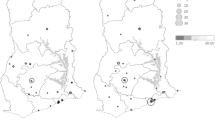Abstract
Background
The critical shortage of surgeons and access to surgical care in Africa is increasingly being recognized as a global health crisis. Across Africa, there is only one surgeon for every 250,000 people and only one for every 2.5 million of those living in rural areas. Surgical diseases are responsible for approximately 11.2% of the total global burden of disease. Even as the importance of treating surgical disease is being recognized, surgeons in sub-Saharan Africa are leaving rural areas and their countries altogether to practice in more desirable locations.
Methods
The Pan-African Academy of Christian Surgeons (PAACS) was formed in 1997 as a strategic response to this profound need for surgical manpower. It is training surgical residents through a 5-year American competency-based model. Trainees are required to be of African origin and a graduate of a recognized medical school.
Results
To date, PAACS has established six training programs in four countries. During the 2009–2010 academic year, there were 35 residents in training. A total of 18 general surgeons and one pediatric surgeon have been trained. Two more general surgeons are scheduled to finish training in 2011. Four graduates have gone on to subspecialty training, and the remaining graduates are practicing general surgery in rural and underserved urban centers in Angola, Guinea-Conakry, Ghana, Cameroon, Republic of Congo, Kenya, Ethiopia, and Madagascar.
Conclusions
The PAACS has provided rigorous training for 18 African general surgeons, one of whom has also completed pediatric surgery training. To our knowledge, this is the only international rural-based surgical training program in Africa.


Similar content being viewed by others
References
Ozgediz D, Riviello R, Rogers SO (2008) The surgical workforce crisis in Africa: a call to action. Bull Am Coll Surg 93:10–16
Pereira C, Cumbi A, Malalane R et al (2007) Meeting the need for emergency obstetric care in Mozambique: work performance and histories of medical doctors and assistant medical officers trained for surgery. BJOG 114:1530–1533
World Health Organization (2008) World Health Report 2008: Primary Health Care, Now More than Ever. http://www.who.int/whr/2008/whr08_en.pdf. Accessed 13 August 2010
Kakande I (2005) The challenge of surgery in Africa. http://www.asecma.org/articulos/Ignatius_Kakande.pdf. Accessed 14 July 2010
Ajay OO, Adebamowa CA (1999) Surgery in Nigeria. Arch Surg 134:206–211
World population prospects: the 2008 revision (2008) Population Division of the Department of Economic and Social Affairs of the United Nations Secretariat. http://esa.un.org/unpp. Accessed 25 July 2010
Mullan F (2005) The metrics of the physician brain drain. N Engl J Med 353:1810–1818
Schmitz CC (2006) Your intergalactic decoder ring has arrived: “Reliability” and “Validity” defined. http://www.facs.org/education/rap/schmitz0506.html. Accessed 13 July 2010
Debas HT, Gosselin R, McCord C et al (2006) Surgery. In: Jamison DT, Breman JG, Measham AR et al (eds) Disease control priorities in developing countries, 2nd edn. Oxford University Press, New York, pp 1245–1260
McCord C, Chowdhury Q (2003) A cost effective small hospital in Bangladesh: what it can mean for emergency obstetric care. Int J Gynecol Obstet 81:83–92
Gosselin RA, Thind A, Bellardinelli A (2006) Cost/DALY averted in a small hospital in Sierra Leone: what is the relative contribution of different services? World J Surg 30:505–511
Gosselin RA, Maldonado A, Elder G (2010) Comparative cost-effectiveness analysis of two MSF surgical trauma centers. World J Surg 34:415–419
Gosselin RA, Heitto M (2008) Cost-effectiveness of a district trauma hospital in Battambang, Cambodia. World J Surg 32:2450–2453
Montagu D, Prata N, Campbell MM et al. (2005) Kenya: reaching the poor throught the private sector—a network model for expanding access to reproductive health services. http://siteresources.worldbank.org/HEALTHNUTRITIONANDPOPULATION/Resources/281627-1095698140167/KenyaMontaguFinal.pdf. Accessed 20 June 2010
WHO-Faith-based Organization Consultation (2007) http://www.chagghana.org/chag/assets/files/FBO%20Meeting%20report%20_2_.pdf. Accessed 14 July 2010
Thomas C (2001) Reviving methodist church hospitals in Africa and Asia. New world outlook. http://gbgm-umc.org/nwo/01ma/reviving.html. Accessed 13 August 2010
Blanchard RJ, Merrell RC, Geelhoed GW et al (2001) Training to serve unmet surgical needs worldwide. J Am Coll Surg 193:417–427
White SM, Thorpe RG, Maine D (1987) Emergency obstetric surgery performed by nurses in Zaire. Lancet 330(8559):612–613
Sani R, Nameoua B, Yahaya A et al (2009) The impact of launching surgery at the district level in Niger. World J Surg 3(10):2063–2068
Sohier N, Frejacques L, Gagnayre R (1999) Design and implementation of a training programme for general practitioners in emergency surgery and obstetrics in precarious situations in Ethiopia. Ann R Coll Surg Engl 81:367–375
De Brouwere V, Dieng T, Diadhiou M et al (2009) Task shifting for emergency obstetric surgery in district hospitals in Senegal. Reprod Health Matters 17:32–44
Population under age 15 (percent) (2009) US global health policy. http://www.globalhealthfacts.org/topic.jsp?i=82. Accessed 25 July 2010
Kingham TP, Kamara TB, Cherian MN et al (2009) Quantifying surgical capacity in Sierra Leone: a guide for improving surgical care. Arch Surg 144:122–127
Joint WHO-MoH facilitators meeting on integrated management for emergency & essential surgical care: towards strengthening primary health care capacities (2008) Monrovia, Liberia. http://infocooperation.org/hss/documents/s15344e/s15344e.pdf. Accessed 13 August 2010
Bickler SW, Kyambi J, Rode H (2001) Pediatric surgery in sub-Saharan Africa. Pediatr Surg Int 17:442–447
Yeo H, Bucholz E, Sosa A et al (2010) A national study of attrition in general surgery training: which residents leave and where do they go? Ann Surg 252:529–536
Author information
Authors and Affiliations
Corresponding author
Rights and permissions
About this article
Cite this article
Pollock, J.D., Love, T.P., Steffes, B.C. et al. Is it Possible to Train Surgeons for Rural Africa? A Report of a Successful International Program. World J Surg 35, 493–499 (2011). https://doi.org/10.1007/s00268-010-0936-z
Published:
Issue Date:
DOI: https://doi.org/10.1007/s00268-010-0936-z




